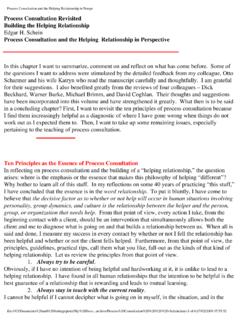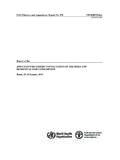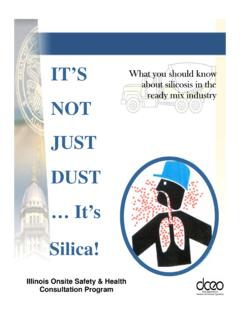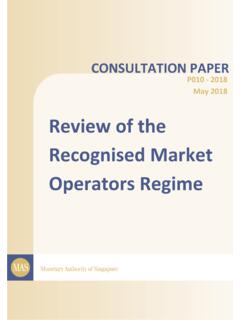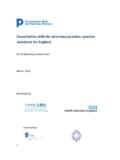Transcription of ANIMAL FEEDING AND FOOD SAFETY
1 IFAO food AND NUTRITION PAPERANIMAL FEEDINGANDFOOD SAFETYR eport of an FAO Expert ConsultationRome, Italy, 10 to 14 March 1997 food AND AGRICULTURE ORGANIZATIONOF THE UNITED NATIONSiiError! Bookmark not designation employed and the presentation of material in this publication do not implythe expression of any opinion whatsoever on the part of the food and AgricultureOrganization of the United Nations concerning the legal status of any country, territory, cityor area or of its authorities, or concerning the delimitation of its frontiers or ! Bookmark not copyright in this document is vested in the food and Agriculture Organization of theUnited Nations. Application for permission to reproduce this book, in whole or in part, byany method or process, should be addressed, with a statement of the purpose and extent ofthe reproduction desired, to the Director, Publications Division, food and AgricultureOrganization of the United Nations, Via delle Terme di Caracalla, 00100 Rome, , Rome, HAZARDS ASSOCIATED WITH spongiform encephalopathies in drugs and agricultural and other and other OF THE OF FEEDBORNE OF FEEDBORNE spongiform of.
2 Code of practice for good ANIMAL FEEDING .. of health factors in the production of ANIMAL feeds: An and intoxications of farm livestock associated with feed and Alimentarius Commission - Standards, guidelines and other recommendations related to the quality and SAFETY of feeds and FAO Expert consultation on ANIMAL FEEDING and food SAFETY was held at FAOH eadquarters in Rome from 10 to 14 March 1997. The consultation participants are listed inAnnex 1. The consultation was opened by Mr. John Lupien, Director of FAO's food andNutrition Division, who welcomed the participants on behalf of the Director-General of FAO,Dr. Jacques welcoming the participants, Mr. Lupien pointed out that FAO has had a long-standinginterest in the relationship between ANIMAL FEEDING , trade and food safety1.
3 Over the yearsproblems such as salmonellae and other pathogenic micro-organisms in feed; aflatoxincontamination in feed affecting poultry and trout and other mycotoxin problems; contaminationof feeds with pesticide residues, heavy metals, and industrial chemicals have created concern atnational and international levels. Such problems can pose risks to human health and significantdifficulties to trade in feed and in food derived from animals. In the past many feed componentshave been handled in ways that were not designed to assure the quality and SAFETY of the finalfeed. Most recently the link that has been drawn between bovine spongiform encephalopathy(BSE) and feed ingredients has given additional impetus towards devising and enforcing strictquality and SAFETY control procedures in all steps of producing, processing and utilization Lupien said that the report of this consultation will help FAO further develop, at theinternational level, the overall scientific basis that is essential to the development of improvedpractices in the FEEDING of animals for the production of food .
4 A recommended code of practicefor good ANIMAL FEEDING would improve overall FEEDING practices and ensure better quality andsafer feeds, and better quality and safer ANIMAL products for human consumption. The report ofthis consultation will be of vital interest to FAO, its member governments and the CodexAlimentarius consultation elected Professor David Fraser as Chairman and Dr. John Wilesmith asVice-Chairman. Dr. Keith Behnke was appointed as Rapporteur. In his opening remarksProfessor Fraser pointed out that because the cost of FEEDING was the major expense in manyanimal production systems, the ANIMAL industries are constantly seeking novel and cheaper feeds,all of which may or may not introduce new contaminants into the food chain.
5 He expressed thehope that the consultation would lead to the formulation of a code of practice for good animalfeeding which would minimise hazards which might arise from feeds during production is a complex process, with the ultimate objective of the food industryand food SAFETY regulators being to ensure that food reaching the consumer is safe andwholesome. food generally expected to be safe may become unsafe due to the introduction ofhazards during production, processing, storage, transport, or final preparation for food derived from animals, the hazard may originate from a number of these and othersources including the consumption by food production animals of contaminated of hazards in food that can be linked to feed and have long been recognisedinclude salmonellosis, mycotoxicosis, and the ingestion of unacceptable residue levels ofveterinary drugs and agricultural and industrial chemicals.
6 In addition, if the postulated linkbetween BSE and the new variant of Creutzfeldt-Jakob Disease (nv-CJD) is established, it wouldbe another example of food contamination originating in feed. 1 Throughout this report, food means any substance, whether processed, semi-processed or raw, ofanimal origin, which is intended for human consumption, and includes milk. The word feed meansany substance whether processed, semi-processed or raw, which is intended for consumption by animalsfrom which food is papers were commissioned by FAO for the consultation . The first paper (Annex 3)addresses feed processing and the second paper (Annex 4) addresses infections and intoxicationsof farm livestock associated with feed and Joint FAO/WHO food Standards Programme, administered by the CodexAlimentarius Commission (CAC), has also done some work in this area in the past.
7 Included inits standards, guidelines and other recommendations are quality and SAFETY standards for meatand various meat products, maximum levels for contaminants, maximum residue levels forresidues of veterinary drugs and pesticides and codes of practice ranging from hygienic practicesto use and control of veterinary drugs. Annex 5 contains a description and summary of theCodex consultation restricted its considerations to food SAFETY matters that pertained strictlyto feeds. It did not consider plant toxins or radionuclides, nor did it consider parasites such asTaenia saginata that are spread by human sewage. In addition, the risks to human health fromfeed or forage contaminated with several other agents such as Bacillus anthracis, Clostridiumbotulinum toxin, Listeria spp.
8 , Mycobacterium bovis and Yersinia spp. appear to be negligible ornon-existent and were therefore not considered by the consultation . It also did not considermanagement practices unrelated to FEEDING , such as vaccination or other veterinary treatmentsincluding the use of injectable agents or drenches. It did not consider spoilage of food productsnor did it consider normal FEEDING practices aimed at maintaining good nutritional status ofproduction there are a great many foods that are of ANIMAL origin, the consultation restrictedits consideration to those foods from common domestic animals which have significance ininternational trade. These include meat and meat products, milk and milk products, eggs and eggproducts, and products of aquatic animals derived from aquaculture.
9 All ANIMAL feeds wereconsidered other than natural unrestricted grazing. The consultation limited its considerations tofood that complies with CAC recommendations, for example meat judged to be fit for humanconsumption in accordance with the Recommended International Code for Ante-mortem andPost-mortem Inspection of Slaughter Animals and for Ante-mortem and Post-mortem Judgementof Slaughter Animals and Meat (CAC/RCP 41-1993). As one example, this excludedconsideration of foodborne products are a major source of food protein in developing countries and oneof the fastest growing systems of food production. There are two broad categories of aquaticanimal production. One involves the production of carnivorous/omnivorous fish using intensivefarming systems and is largely dependent upon the use of compounded feed, while the other isbased on the mass production of herbivorous/filter FEEDING fish species withinsemi-intensive/extensive farming systems based on the use of agricultural and other by-products,including ANIMAL manure, as fertilizer or supplementary feed inputs.
10 Intensive fish farming usingcompounded feed therefore clearly fell within the scope of the consultation . However, assemi-intensive/extensive systems are being considered by the WHO/FAO/NACA2 Study Groupon food SAFETY Issues associated with Products from Aquaculture, this was not TRADEThe Uruguay Round of Multilateral Trade Negotiations established a new World TradeOrganization (WTO) and included negotiations on reducing non-tariff barriers to internationaltrade. Included in the Final Act were the Agreements on the Application of Sanitary andPhytosanitary Measures (the SPS Agreement) and on Technical Barriers to Trade (the TBTA greement). Both Agreements have implications for the work of the Codex AlimentariusCommission.










